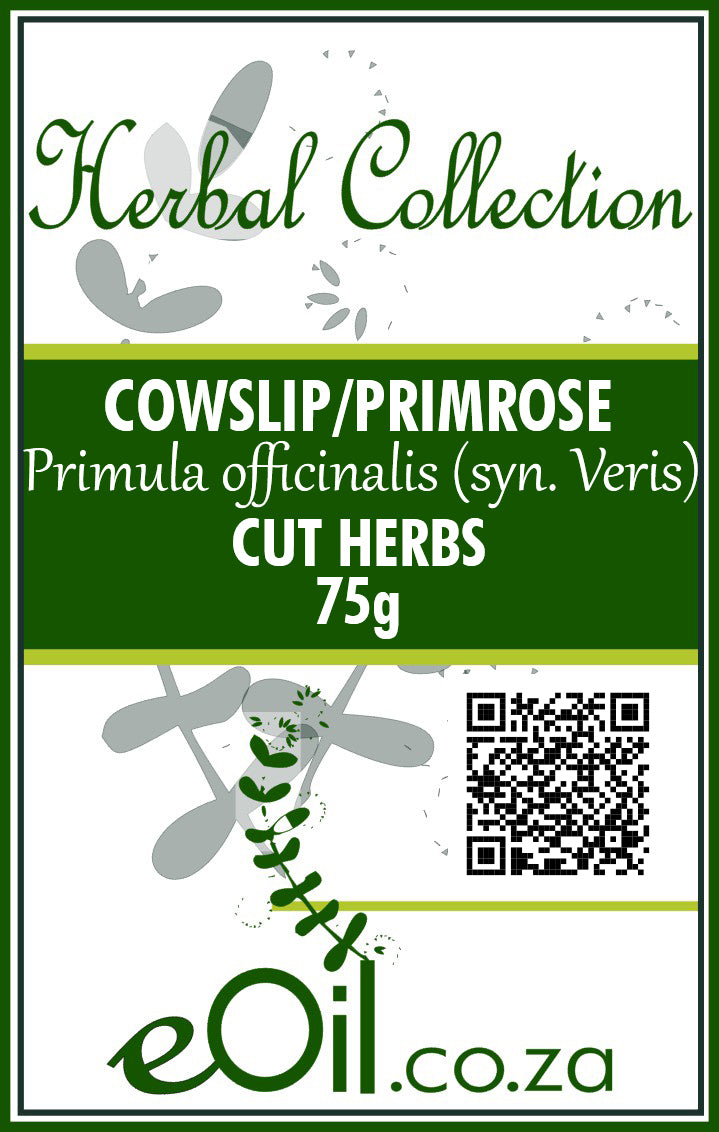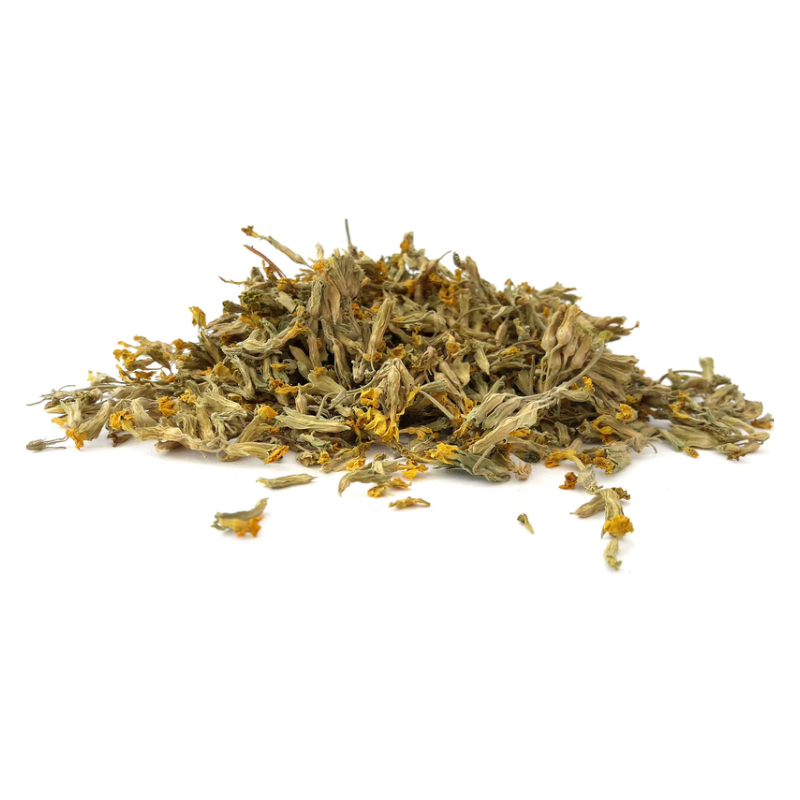Primrose Cowslip Dried Herb - Herbal Collection
Primrose Cowslip Dried Herb - Herbal Collection - 75 GR is backordered and will ship as soon as it is back in stock.
Description
Description
Premium Dried Cowslip (Primrose Herb) from eOil.co.za’s Herbal Collection offers the carefully harvested and dried flowers and aerial parts of Primula veris, known in European herbal medicine as cowslip or primrose.
Renowned for its subtle fragrance and wellness properties, this herb is traditionally used to soothe the nervous system, support respiratory function, and promote mild cardiovascular well-being.
TRADITIONALLY USED FOR
- It may be useful as a relaxing, sedative remedy
- Useful for stress and tension, relaxing nervous excitement and facilitating restful sleep
- For inflammatory of the heart muscle, dropsy and tendency to stroke
- To expel stones in the bladder
- For nervous headaches, migraine and insomnia
- Use for bronchitis, colds, chills and coughs
INFORMATION
Source : http://www.wikiphyto.org/wiki/Primevere
Reference on http://www.wikiphyto.org
Translation in English by Google Translate (go to the page of the source linked | on Chrome cellphones go on the 3 dots on the top right and select translate in your preferred language | on laptop right click your mouse and select option translate when hoovering on the page
plant name
Primrose, Cuckoo
International Latin denomination
Primula veris L. syn. Primula officinalis (L.) Hill. and Primula elatior (L.) Hill.
botanical family
Primulaceae
Description and habitat
- Herbaceous about 20 cm tall, pubescent
- Basal rosette leaf blade wrinkled, crinkled
- Gamopetalous golden-yellow fragrant flowers
- Hairy flower stalk, sometimes with up to 30 flowers
History and tradition
- Was used as an indigenous substitute for the Polygala
Parts used
- flower and root
Dosage forms available
Primula officinalis tincture whole plant
Usual dosages
- Flowers: 2 - 4 g of drug per day
- Roots: 0.5 to 1.5 g of drug
Composition
Main components of the plant
- Flowers: saponosides (especially in the sepals) whose aglycone is primulic acid A
- Flavonoids : rutinoside , quercetin , luteolin , kaempferol , isorhamnetin , apigenin , quercetin 3-O-glucoside , robinobioside , gentiobioside
- Lipophilic [1] and methoxylated flavones: 3 ',4',5'-trimethoxyflavone , mono-, di-tri- and pentamethoxyflavones [2] which are chemotaxonomic markers of the genus Primula
- Epicatechin , epigallocatechin , proanthocyanidin B 2 [3]
- Carotenoids , essential oil , enzymes ( primverase ), sugar alcohols
- Flavonoids : rutinoside , quercetin , luteolin , kaempferol , isorhamnetin , apigenin , quercetin 3-O-glucoside , robinobioside , gentiobioside
- Roots:
- Triterpene saponins : anagalligenin , privaterogenin B , protoprimulagenin A [4] , [5]
- Phenolic glycosides ( primulaverine = primulaveroside )
- Sugars including rare sugars ( primrose )
- Traces of tannins
Main components of buds or young shoots
Main components of essential oil
Properties
Plant properties
- Flower :
- Mild secretolytic and expectorant, mild sedative
- The hydro-alcoholic extract exhibits antibacterial and antimitotic properties [6]
- Locally: softening, antipruritic, protective trophic in cracks, abrasions, chapped skin, insect bites
- Root: expectorant (secretogenic and secretolytic) by saponosides (see mode of action)
- Saponosides are also bacteriostatic and antiviral ( Influenza A )
- Plant:
- Cardioprotective, increases myocardial contractility ( flavonoids : apigenin , quercetin , kaempferol , cynaroside , rutin , hyperoside , polymethoxylated flavones: 8-methoxy-flavone , 3′,4′methylenedioxy-5′-methoxyflavone ) [7]
Bud properties
Properties of essential oil
Directions
Indications of the whole plant (phytotherapy)
- Cough and bronchitis (flowers and roots)
- Whooping cough, asthma, gout, neuralgia
- Headaches, neuralgia, tremors, dizziness (flowers)
- It was used in Danish folk medicine to treat convulsions and epilepsy [8]
Indications of the bud (gemmotherapy)
Specific indications of essential oil (aromatherapy)
Known or suspected mode of action
- Saponosides cause local irritation of the gastric mucosa, causing a vagal reflex stimulating bronchial secretion, causing dilution of mucus and decrease in its viscosity
- And surfactant effect of saponosides which also increase the ciliary activity of the epithelium
- The enzymatic degradation of primulaverine during the drying of the root gives rise to aromatic principles, such as the methyl ester of 5-methoxy-salicylic acid
Usual formulations
Regulations
- French Pharmacopoeia list A (flower, underground part)
Possible side effects and precautions for use
- Allergy to Primulaceae : dermatitis, erythema
- Gastric disorders with horticultural varieties (presence of allergenic alkylbenzoquinones )
Bibliographic references
- Aller↑ Jaromir Budzianowski, Maria Morozowska, Maria Wesołowska. Lipophilic flavones of Primula veris L. from field cultivation and in vitro cultures. Phytochemistry, Volume 66, Issue 9, 2005, Pages 1033-1039, https://doi.org/10.1016/j.phytochem.2005.03.024 .
- Aller↑ Huck, CW, Huber, CG, Ongania, KH, & Bonn, GK (2000). Isolation and characterization of methoxylated flavones in the flowers of Primula veris by liquid chromatography and mass spectrometry. Journal of chromatography. A, 870(1-2), 453–462. https://doi.org/10.1016/s0021-9673(99)00950-4 . PMID 10722102
- Aller↑ Karl C, Muller G, Pedersen PA. Flavonoids in the flowers of Primula officinalis. PlantaMed. 1981 Jan;41(1):96-9. PMID 17401825
- Aller↑ Grecu L, Cucu V. Saponins from Primula officinalis and P. elatior. PlantaMed. 1975May;27(3):247-53. German. PMID 1161889
- Aller↑ Okršlar, V., Plaper, I., Kovač, M. et al. Saponins in tissue culture of Primula veris L.. In Vitro Cell.Dev.Biol.-Plant 43, 644–651 (2007). https://doi.org/10.1007/s11627-007-9072-3
- Aller↑ Başbülbül, G., Özmen, A., Biyik, HH, & Şen, Ö. (2008). Antimitotic and antibacterial effects of the Primula veris L. flower extracts. Caryologia, 61(1), 88-91. DOI: 10.1080/00087114.2008.10589614
- Aller↑ Latypova GM, Bychenkova MA, Katayev VA, Perfilova VN, Tyurenkov IN, Mokrousov IS, Prokofiev II, Salikhov SM, Iksanova GR. Composition and cardioprotective effects of Primula veris L. solid herbal extract in experimental chronic heart failure. Phytomedicine. 2019 Feb 15;54:17-26. doi: 10.1016/j.phymed.2018.09.015. PMID 30668367 .
- Aller↑ Jäger, AK, Gauguin, B., Adsersen, A., & Gudiksen, L. (2006). Screening of plants used in Danish folk medicine to treat epilepsy and convulsions. Journal of ethnopharmacology, 105(1-2), 294–300. https://doi.org/10.1016/j.jep.2005.10.015
CAUTION
Store in a cool, dry place, away from light. Keep tightly closed, away from the reach of Children and pets.
Do not exceed the daily dose.
This product is not intended to prevent or cure any form of illness or disease.
If you are pregnant or nursing ; If you have a medical condition or are in the course of medical treatment ; If you are programmed for theater/operation in the near future, please consult your healthcare practitioner before using this product.
This product cannot replace a varied and balanced diet and a healthy lifestyle.
This product has not been evaluated by the SAHPRA for its quality, safety or intended use.
For More Information please check our General Safety Herbal products Page






